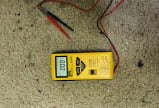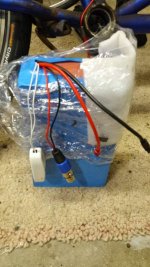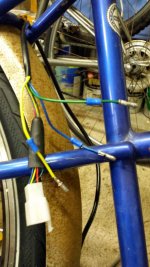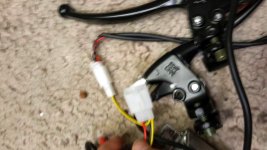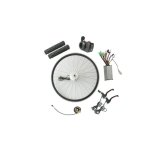NeilP
1 GW
Well D8veh suggestion to try connecting tnose wires only really holds true if he has experiece with that exact controller and wiring scheme. Otherwise you are just 'shooting in the dark
I don't understand your last paragraph about linking the battery black to PAS with the meter. You don't link anything 'through ' the meter unless you are measuring current. If you don't understand the basics of using a voltmeter to measure voltage, we are getting into dangerous ground, but I'll try and explain.
Picture of your meter will help us guide you
start with your meter in Volts mode at a high enough setting for your battery pack
Black and red meter leads plugged into corrrct sockets on meter.
Battery disconnected
Now put
black meter lead to black battery lead
Red meter lead to red battery lead
Flick the switch on your battery pack to work out which position is 'ON'. That will be the highest reading the meter gives. It may not go down to zero again immediately it is switched off. If it does nto seem to change, then leave the meter connected, and leave the switch in one position. and leave if for a few minutes, monitoring the voltage ont he display. If it goes down you have foudn the off position. If not, try the other position.
To learn a bit more about your meter, leave battery switch for now in 'ON' position and swap the meter leads on the battery. so red to black and black to ref. look at the meter display, note that it will now have a negative symbol in front of the voltage. That indicates tjat the vltage at the red lead is lower than the black lead.... The polarity is wrong, which in this case is obvious as the leads on the battety are colour coded. So now you can measure voltage and check polarity.
Now switch battery off and connect to controller
Switch battery ON
Nothing else connected to controller
Connect black meter lead to black battery connection, you will probably have to shove the probe tip the back of the black anderson, connection... you are 'T'ing ' off the battety controller connection
Now using the red lead from the meter go around all the other wires and see what voltage is on each one. If the controller is off, as it shoudl be with only battery connected, you should find one of maybe two wires at full battery volotage and that shoudl be it
Does the throttle have a switch and 'Fuel gauge' ? I believe I have already asked this once before?
If you know which is throttle plug from the controller and it does have on/off switch , then chances are it also had full battery voltage on one of the wires on the controller side of that throttle plug
Maybe now connect throttle to controller and with switch in both positions, check all other wires again. You should now see 5volts on some of the small red wires. When you do, then controller is 'on'
BUT. ....... I believe previously you had connected some of those loose single wires to the big red wire ? If you have done that, it may already be too late, you may have already fried the 5 volt regulator stage by feedimg 50 volts up it the wrong way
Apologies for poor spelling. Half closed eyes, fat fingers and iphone keybboard at 2 in the morning from bed here..edit..mostly corrected now
I don't understand your last paragraph about linking the battery black to PAS with the meter. You don't link anything 'through ' the meter unless you are measuring current. If you don't understand the basics of using a voltmeter to measure voltage, we are getting into dangerous ground, but I'll try and explain.
Picture of your meter will help us guide you
start with your meter in Volts mode at a high enough setting for your battery pack
Black and red meter leads plugged into corrrct sockets on meter.
Battery disconnected
Now put
black meter lead to black battery lead
Red meter lead to red battery lead
Flick the switch on your battery pack to work out which position is 'ON'. That will be the highest reading the meter gives. It may not go down to zero again immediately it is switched off. If it does nto seem to change, then leave the meter connected, and leave the switch in one position. and leave if for a few minutes, monitoring the voltage ont he display. If it goes down you have foudn the off position. If not, try the other position.
To learn a bit more about your meter, leave battery switch for now in 'ON' position and swap the meter leads on the battery. so red to black and black to ref. look at the meter display, note that it will now have a negative symbol in front of the voltage. That indicates tjat the vltage at the red lead is lower than the black lead.... The polarity is wrong, which in this case is obvious as the leads on the battety are colour coded. So now you can measure voltage and check polarity.
Now switch battery off and connect to controller
Switch battery ON
Nothing else connected to controller
Connect black meter lead to black battery connection, you will probably have to shove the probe tip the back of the black anderson, connection... you are 'T'ing ' off the battety controller connection
Now using the red lead from the meter go around all the other wires and see what voltage is on each one. If the controller is off, as it shoudl be with only battery connected, you should find one of maybe two wires at full battery volotage and that shoudl be it
Does the throttle have a switch and 'Fuel gauge' ? I believe I have already asked this once before?
If you know which is throttle plug from the controller and it does have on/off switch , then chances are it also had full battery voltage on one of the wires on the controller side of that throttle plug
Maybe now connect throttle to controller and with switch in both positions, check all other wires again. You should now see 5volts on some of the small red wires. When you do, then controller is 'on'
BUT. ....... I believe previously you had connected some of those loose single wires to the big red wire ? If you have done that, it may already be too late, you may have already fried the 5 volt regulator stage by feedimg 50 volts up it the wrong way
Apologies for poor spelling. Half closed eyes, fat fingers and iphone keybboard at 2 in the morning from bed here..edit..mostly corrected now


